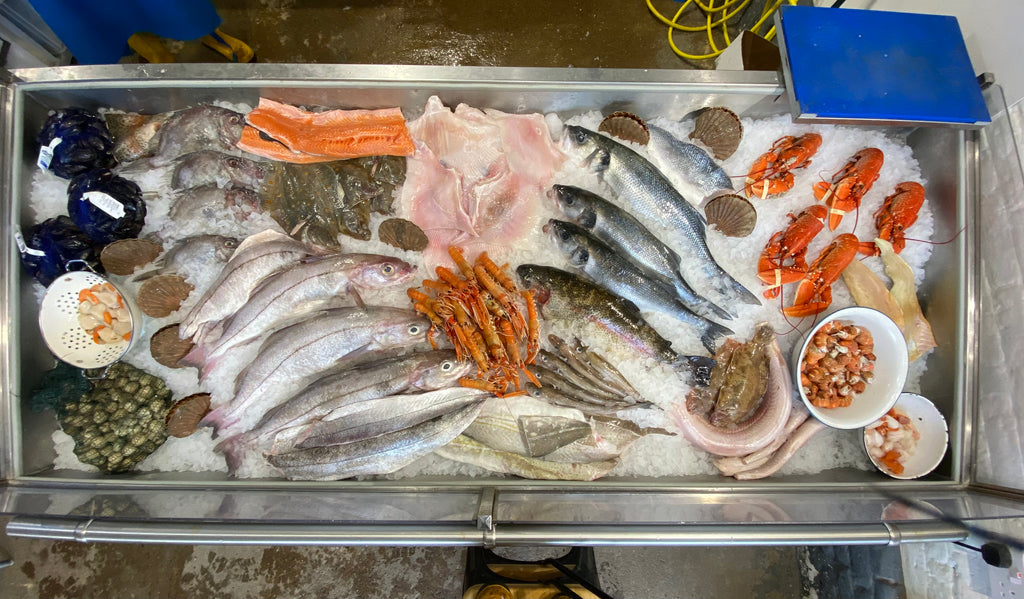Meet the Supplier: A Passion for Seafood
by Robert Gooch July 07 2022
We’re delighted to be working with A Passion for Seafood to offer you a delicious range of seasonal and traceable native fish and shellfish landed from UK waters. Founded by Mike Warner, they supply the best of British catches, while helping people to understand the ‘net to plate’ journey of their fish.
We caught up with Mike to find out more about A Passion for Seafood and the importance of making sustainable choices that help to sustain British fishing communities as well as fish stocks.

1. Where did your interest in fish and fishing come from?
It started in childhood. I grew up at Felixstowe Ferry [a fishing village north of Felixstowe, Suffolk] and my father used to fish. Summers were spent on the beach watching the fishermen, and I was mesmerised. I bought my own lobster pots and went out on the boats. Then at eighteen, I was split between fishing or pursuing my interest in agriculture. In the end, I went to agricultural college and worked in farm management for many years before I moved into consultancy and began working with chefs interested in the provenance of their ingredients. This gave me an opportunity to use my knowledge for British fish to help chefs share their ‘net to plates’ stories, and once again go out to sea. Around the same time, I started my blog to share my passion for the diversity of fish and shellfish being caught around the UK.
2. How did A Passion for Seafood get started?

In the pandemic, when fishermen lost many of the markets for their fish, I began buying their fish direct from them to supply to chefs and consumers. I began with the fishermen from Felixstowe Ferry, who catch the superb wild bass that is now available through the Wild Meat Company. I then used my fishing contacts around the UK to buy other native species to offer a diverse and traceable range throughout the year.
3. Can you tell us where the other species you supply for the Wild Meat Company are caught?
Our cod is caught off the Scottish coast, where there are now really good fishing stocks. We’re now seeing so much cod that people can once again feel good about eating it when it comes from stocks that are locally sustainable. Our hake, lemon sole, monkfish and langoustine also come from Scottish waters or Devon or Cornwall. And our ChalkStream trout is reared sustainably in clear chalk stream rivers in Hampshire.
4. Why is ChalkStream trout a better option than farmed salmon?
Much of the salmon that people eat has been farmed intensively. This leads to problems with sea lice, pollution and degradation of the environment. We decided not to sell salmon because we’d rather people tried alternatives that are being sustainably produced here in Britain. And ChalkStream trout really is a wonderful alternative. It’s reared in running water – we call it ‘ranching’ – and stocking rates are kept low, so the fish have plenty of space. They feed naturally with only a small amount of supplementary feed, and their stress levels are low.

5. Would you like to see more people eating British seafood?
I would love to see people eating more native species caught in UK waters. A Passion for Seafood was set up to showcase the best of British seafood and reconnect consumers to fishermen and their seasonal catches. Seventy per cent of the seafood we eat in the UK is imported, while most of what our fishermen catch is exported. We’d love to see people diversifying, instead of buying the same few imported species. The funny thing is, when Brits are on holiday abroad, they will happily eat fish that they never eat at home without realising that what they’re eating may have been caught in the UK!
6. Which underrated species would you recommend people try?
I would have to say langoustines. Ninety per cent of langoustines caught in the UK go abroad, and then we import king prawns from Southeast Asia. We’d love to see people swapping their king and tiger prawns for langoustines to support our fishing communities. They taste very similar but are slightly sweeter with a superb light texture. And you can serve them in just the same ways.

7. What should people concerned with eating sustainably look out for when choosing fish?
The first thing is seasonality. We only buy fish that is in season, when it will also taste its very best.
The second thing is traceability. People should know where, why and how their fish has been caught to ensure that it has been fished responsibly.
8. What are your favourite ways to eat fish and shellfish?
I like to eat seasonally and enjoy the variety that is available locally throughout the year. I love trying different things and buying fishermen’s whole catches!
When I eat langoustines, I like to split them in half and barbecue or grill them, then eat them hot with a little aioli. Or I might poach them in salted water. They’re done in about three minutes and perfect with pasta or risotto.
White fish, I pan fry skin-side down with a little butter or bake, steam or sous vide. I also like to make fish pies or cook white fish fillets in sauce. Hake or cod Florentine are really good. And so is homemade fish and chips with a beer batter!
Monkfish is great in a curry or stir fry. And we also like to thread it onto skewers to make monkfish kebabs with a little Szechuan pepper. Or you can wrap the fillets in prosciutto or Parma ham, spread over some pesto and wrap them in puff pastry to make monkfish en croute.
Feeling hungry? You can find our full range of fish and shellfish here, along with more cooking tips to whet your appetite!

